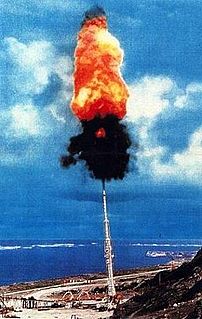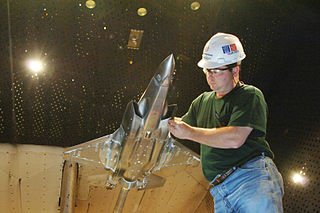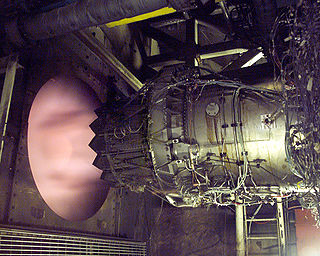| AEDC Range-G | |
|---|---|
 G Range shown on the Left | |
| Active | 1962–Present |
| Country | United States |
| Branch | US Air Force |
| Role | Test Facility |
| Nickname(s) | G-Range |
AEDC Range G is a two-stage light-gas gun owned by the United States Air Force.
| AEDC Range-G | |
|---|---|
 G Range shown on the Left | |
| Active | 1962–Present |
| Country | United States |
| Branch | US Air Force |
| Role | Test Facility |
| Nickname(s) | G-Range |
AEDC Range G is a two-stage light-gas gun owned by the United States Air Force.
Constructed in 1962, the AEDC Range-G is the largest routinely operated light-gas gun in the United States. It is located at Arnold Engineering Development Complex on Arnold Air Force Base. The design of the range came from collaboration between German and American scientists after World War II. [1] Range-G has played a crucial role in lethality development for many defense programs. [2] The range has performed more than 7,000 high speed launches.
Range G is capable of launching projectiles up to speeds of 7 km/s (22,965 ft/s). The gun has an interchangeable barrel that can accommodate projectile diameters of 3.3 inches, 4.0 inches, and 8.0 inches. The projectile is launched into a 10 ft diameter test chamber that is approximately 1000 ft long. This chamber can be conditioned to pressures from 0.2 torr (26.7 pascals) to 1.7 atmospheres (172 kilopascals). [3] Sections of the tank can also be configured to simulate possible flight conditions such as rain or snow.
Currently the facility offers a wide variety of instruments for hyperballistic testing. Instruments are available for making measurements related to the flight of the projectile and the target impact event. Instrumentation includes shadowgraph cameras, high speed video cameras, and multiple plane digital x-ray sensors. The range personnel have in-depth experience with the design and analysis of projectiles under gun conditions. AEDC also operates a fully staffed machine shop capable of fabricating complex projectiles for any of the available barrel sizes.

A shotgun is a firearm that is usually designed to be fired from the shoulder, which uses the energy of a fixed shell to fire a number of small spherical pellets called shot, or a solid projectile called a slug. Shotguns come in a wide variety of sizes, ranging from 5.5 mm (.22 inch) bore up to 5 cm (2.0 in) bore, and in a range of firearm operating mechanisms, including breech loading, single-barreled, double or combination gun, pump-action, bolt-, and lever-action, revolver, semi-automatic, and even fully automatic variants.

The Ames Research Center (ARC), also known as NASA Ames, is a major NASA research center at Moffett Federal Airfield in California's Silicon Valley. It was founded in 1939 as the second National Advisory Committee for Aeronautics (NACA) laboratory. That agency was dissolved and its assets and personnel transferred to the newly created National Aeronautics and Space Administration (NASA) on October 1, 1958. NASA Ames is named in honor of Joseph Sweetman Ames, a physicist and one of the founding members of NACA. At last estimate NASA Ames has over US$3 billion in capital equipment, 2,300 research personnel and a US$860 million annual budget.

In firearms, rifling refers to the helical groovings that are machined into the internal (bore) surface of a gun's barrel, for the purpose of exerting torque and thus imparting a spin to a projectile around its longitudinal axis during shooting. This spin serves to gyroscopically stabilize the projectile by conservation of angular momentum, improving its aerodynamic stability and accuracy over smoothbore designs.

In guns, particularly firearms, caliber is the specified nominal internal diameter of the gun barrel bore regardless of how or where the bore is measured and whether or not the finished bore matches that specification. It is measured in inches to an accuracy of hundredths or thousandths of an inch or in millimeters. For example, a ".45 caliber" firearm has a barrel diameter of roughly 0.45 inches (11 mm). Barrel diameters can also be expressed using metric dimensions. For example, a "9 mm pistol" has a barrel diameter of about 9 millimeters. Due to the inaccuracy and imprecision of imperial dimensions "converted" to metric units, metric designations are typically far out of specifications published in decimal inches. True "caliber" specifications require imperial measure, and even when cartridge designations only specify caliber to even tenths or hundredths of an inch, actual barrel/chamber/projectile dimensions are published to at least thousandths of an inch and frequently tolerances extend into ten-thousandths of an inch.

Recoil is the backward movement of a gun when it is discharged. In technical terms, the recoil momentum acquired by the gun exactly balances the forward momentum of the projectile and exhaust gases (ejecta), according to Newton's third law, known as conservation of momentum. In hand-held small arms, the recoil momentum is transferred to the ground through the body of the shooter, while in heavier guns, such as mounted machine guns or cannons, recoil momentum is transferred to the ground through the mount.
Muzzle velocity is the speed of a projectile at the moment it leaves the end of a gun's barrel. Firearm muzzle velocities range from approximately 120 m/s (390 ft/s) to 370 m/s (1,200 ft/s) in black powder muskets, to more than 1,200 m/s (3,900 ft/s) in modern rifles with high-velocity cartridges such as the .220 Swift and .204 Ruger, all the way to 1,700 m/s (5,600 ft/s) for tank guns firing kinetic energy penetrator ammunition. To simulate orbital debris impacts on spacecraft, NASA launches projectiles through light-gas guns at speeds up to 8,500 m/s (28,000 ft/s).

Project HARP, short for High Altitude Research Project, was a joint project of the United States Department of Defense and Canada's Department of National Defence created with the goal of studying ballistics of re-entry vehicles at low cost; whereas most such projects used expensive and failure-prone rockets, HARP used a non-rocket spacelaunch method based on a very large gun to fire the models to high altitudes and speeds.

A sabot is a structural device used in firearm or cannon ammunition to keep a sub-caliber flight projectile, such as a relatively small bullet or arrow-type projectile, in the center of the barrel when fired, if the bullet has a significantly smaller diameter than the bore diameter of the weapon used.
Internal ballistics, a subfield of ballistics, is the study of the propulsion of a projectile.

Arnold Engineering Development Complex (AEDC), Arnold Engineering Development Center before July 2012, located at Arnold Air Force Base, Tennessee is a ground-based flight test facility operated by the Air Force Test Center.

In current usage a riot gun or less-lethal launcher is a type of firearm that is used to fire "non-lethal" or "less-lethal" ammunition for the purpose of suppressing riots. Less-lethal launchers may be special purpose firearms designed for riot control use, or standard firearms, usually shotguns and grenade launchers, adapted to riot control use with appropriate ammunition. The ammunition is most commonly found in 12 gauge shotguns and 37mm or 40 mm grenade launchers.

The light-gas gun is an apparatus for physics experiments, a highly specialized gun designed to generate very high velocities. It is usually used to study high-speed impact phenomena, such as the formation of impact craters by meteorites or the erosion of materials by micrometeoroids. Some basic materials research relies on projectile impact to create high pressure: such systems are capable of forcing liquid hydrogen into a metallic state.

Arnold Air Force Base is a United States Air Force base located in Coffee and Franklin counties, Tennessee, adjacent to the city of Tullahoma. It is named for General Henry "Hap" Arnold, the father of the U.S. Air Force.
The University of Texas at Arlington Aerodynamics Research Center (ARC) is a facility located in the southeast portion of the campus operated under the Department of Mechanical and Aerospace Engineering. It was established in 1986 as part of an expansion of UTA's College of Engineering. The ARC contributes to the vision of UTA and the University of Texas System to transform the university into a full-fledged research institution. It showcases the aerodynamics research activities at UTA and, in its history, has established itself as a unique facility at a university level. The wind tunnels and equipment in the facility were mainly built by scouting for and upgrading decommissioned equipment from the government and industry. Currently, Masters and Ph.D. students perform research in the fields of high-speed gas dynamics, propulsion, and Computational fluid dynamics among other projects related to aerodynamics.

A potato cannon is a pipe-based cannon which uses air pressure (pneumatic), or combustion of a flammable gas, to launch projectiles at high speeds. They are built to fire chunks of potato, as a hobby, or to fire other sorts of projectiles, for practical use. Projectiles or failing guns can be dangerous and result in life-threatening injuries, including cranial fractures, enucleation, and blindness if a person is hit.
Expansion and shock tunnels are aerodynamic testing facilities with a specific interest in high speeds and high temperature testing. Shock tunnels use steady flow nozzle expansion whereas expansion tunnels use unsteady expansion with higher enthalpy, or thermal energy. In both cases the gases are compressed and heated until the gases are released, expanding rapidly down the expansion chamber. The tunnels reach speeds from Mach 3 to Mach 30 to create testing conditions that simulate hypersonic to re-entry flight. These tunnels are used by military and government agencies to test hypersonic vehicles that undergo a variety of natural phenomenon that occur during hypersonic flight.
AEDC Ballistic Range S-3 is a single stage air gun owned by the United States Air Force. The gun is commonly used for bird strike testing and is often called a chicken gun.

In artillery, caliber or calibre is the internal diameter of a gun barrel, or by extension a relative measure of the length.

AEDC Hypervelocity Wind Tunnel 9 is a hypersonic wind tunnel owned by the United States Air Force and operated by National Aerospace Solutions The facility can generate high Mach numbers and high Reynolds for hypersonic ground testing and the validation of computational simulations for the Air Force and Department of Defense.
The AEDC Space Chambers Test Facility, located at Arnold Engineering Development Complex, contains several test units used for simulating space conditions. The facility has a variety test cells to accommodate various sized test articles. Test articles range in size from the sensor level all the way up to full-scale space systems. All test units in the facility are owned by the United States Air Force and currently operated by Aerospace Testing Alliance.